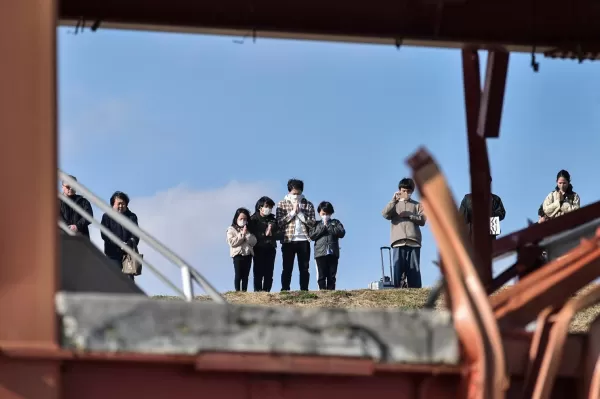In recent weeks, a previously little-known manga has captured widespread attention in Japan and beyond. In “The Future I Saw,” author Ryo Tatsuki predicts a catastrophic natural disaster will strike Japan in July 2025. This forecast has prompted some travelers to cancel their summer trips to Japan and has sparked a frenzy on Japanese social media. Why are some taking Tatsuki’s predictions seriously? And how has an upcoming Japanese horror film become entangled in this wave of concern?
Ryo Tatsuki’s manga “The Future I Saw” debuted in 1999. It portrays Tatsuki as a character, drawing from dream diaries she has maintained since 1985. The 1999 edition’s cover depicts Tatsuki’s character with a hand to one eye, with postcards above her head alluding to various “visions” she claims to have foreseen. One postcard references “March 2011: A Great Disaster.” Following the catastrophic Tohoku Earthquake and Tsunami in March 2011, Tatsuki’s manga regained attention, with out-of-print copies fetching high prices at auctions.
 People pray during a moment of silence to honor victims on the 14th anniversary of the 2011 earthquake, tsunami, and nuclear disaster. Photo by STR/JIJI PRESS/AFP via Getty Images.
People pray during a moment of silence to honor victims on the 14th anniversary of the 2011 earthquake, tsunami, and nuclear disaster. Photo by STR/JIJI PRESS/AFP via Getty Images.In 2021, Tatsuki released “The Future I Saw: Complete Edition,” introducing a new prophecy: a massive natural disaster in July 2025, with a tsunami three times larger than the 2011 event. Given her accurate 2011 prediction, news of this 2025 warning spread rapidly across Japanese social media.
Reports suggest Tatsuki’s July 2025 prophecy may have led some superstitious individuals to avoid traveling to Japan this summer. The impact appears most notable in Hong Kong, where the manga is available in translation, though the extent of the decline remains unclear. According to Sankei Shimbun and CNN, Hong Kong-based fortune-teller and TV personality Master Seven has amplified Tatsuki’s prediction, warning of heightened earthquake risks in Japan from June to August this year.
Japanese media has highlighted responses from Hong Kong-based airlines. ANN News and other outlets reported that Hong Kong Airlines canceled its three weekly flights to Sendai, a city heavily affected by the 2011 earthquake. Similarly, Greater Bay Airlines is cutting direct flights from Hong Kong to Sendai and Tokushima from May to October, citing reduced travel demand linked to the disaster prophecy and economic uncertainty. At an April press conference, Miyagi Prefecture Governor Yoshihiro Murai, where Sendai is located, dismissed the predictions as “unscientific” and encouraged travelers to disregard them.
The surge in media coverage has thrust “The Future I Saw” back into the spotlight. On May 23, reports indicated the Complete Edition sold over 1 million copies. This renewed interest aligns with the upcoming release of a horror movie, “July 5 2025, 4:18 AM,” hitting Japanese theaters on June 27. The film, inspired by Tatsuki’s July 2025 prediction, follows a protagonist whose birthday falls on July 5 as strange events unfold. The media buzz around the manga likely boosts the film’s visibility.
However, some social media posts and videos in Japan have misrepresented the movie’s title as the exact date and time of the predicted disaster, blending scientific earthquake data with sensationalized warnings. This prompted publisher Asuka Shinsha to issue a statement: “We wish to clarify that the author (Tatsuki) did not specify the date and time mentioned in the movie title. We urge people to avoid being misled by incomplete information in the media and on social platforms.”
Japan frequently faces natural disasters, from earthquakes and tsunamis to floods and landslides. While Tatsuki’s prediction may lack scientific grounding, it taps into a broader, evidence-based concern. Seismologists estimate a 70-80% chance of a Nankai Trough megaquake striking Japan within the next 30 years, according to Asahi News and Kobe University. In March 2025, the government updated its projections, estimating a Nankai Trough quake could affect major cities, cause around 300,000 deaths, and trigger massive tsunamis. Alarmist posts often merge Tatsuki’s prophecy with these scientific estimates, despite the Japan Meteorological Agency labeling such specific predictions as “hoaxes” on its homepage. Tatsuki’s 2011 prediction may have been a fortunate coincidence.
Many Japanese-speaking users on X have criticized the media frenzy and panic surrounding Tatsuki’s prophecy. “It’s foolish to trust disaster predictions from a manga. The Nankai Trough quake could strike anytime,” one user remarked. Tatsuki herself addressed the attention in Mainichi Shimbun, expressing hope that her manga’s popularity might boost disaster preparedness but urging people not to be overly swayed by her predictions and to follow expert guidance.


 LATEST ARTICLES
LATEST ARTICLES 












